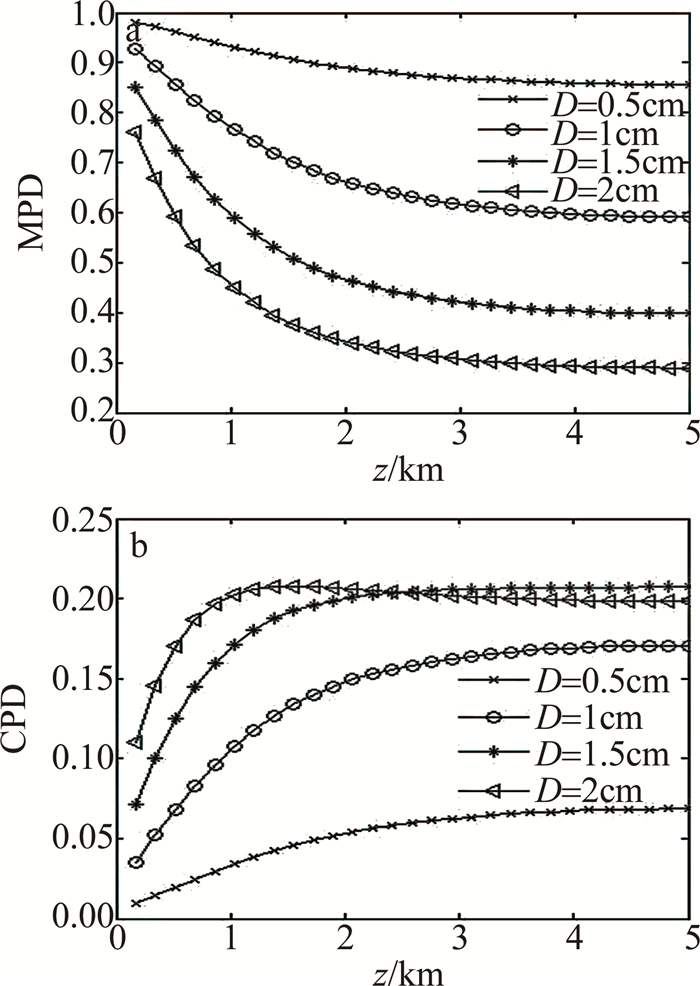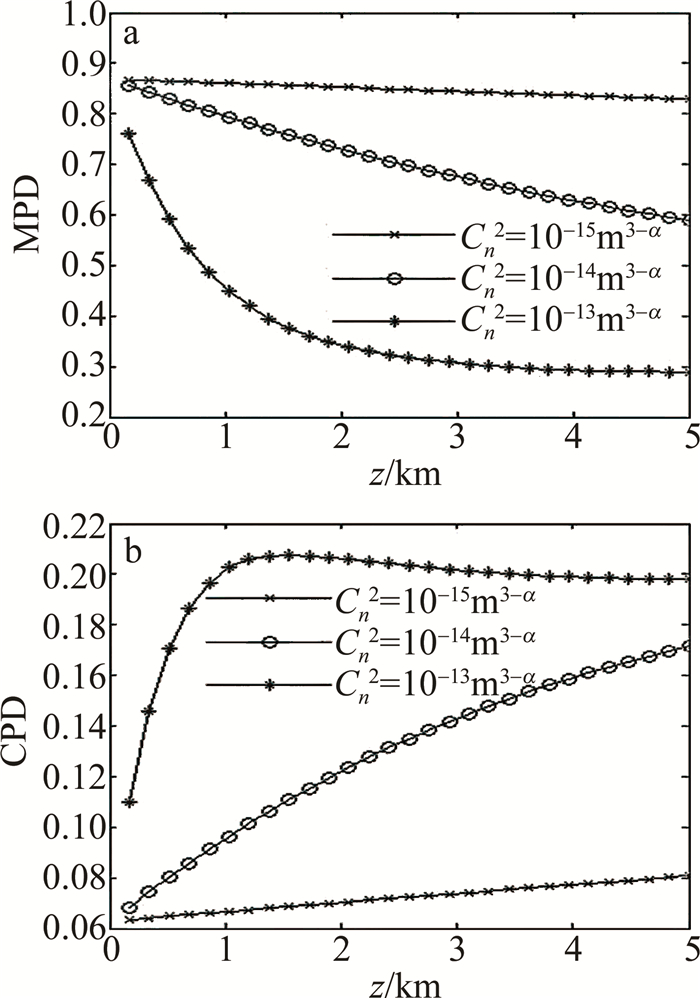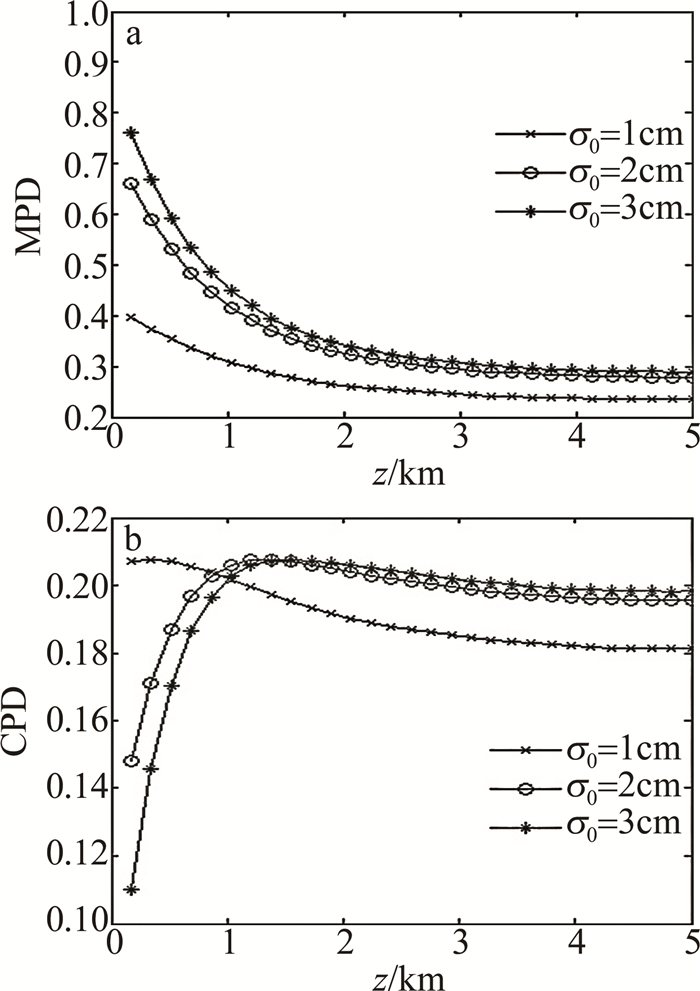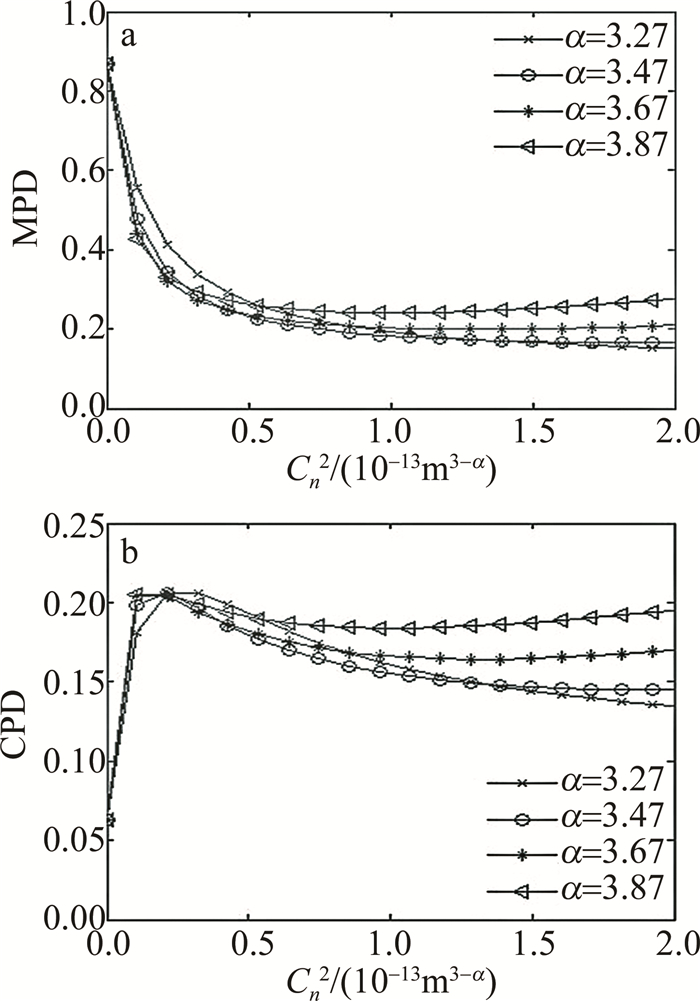HTML
-
随着通信行业的快速发展,社会对通信速率的要求越来越高,传统的无线电通信不能满足用户的需求。为了弥补数据共享时代数据传输的压力,近些年来,自由空间光通信(free space optical communication, FSO)成为研究的热点,光作为信息传输的载体,具有非常高的可用光带宽,能够实现两个定点间的高速率传输,并且传输距离可达数千米[1-3]。研究发现,光不仅有自旋角动量,而且涡旋光束中每个光子都携带轨道角动量(orbital angular momentum, OAM)[4], 轨道角动量可作为信息传输的载体。涡旋光束具有特殊的相位结构和确定的轨道角动量,在无线光通信领域备受关注[5-7]。由于不同模态的OAM光束相互正交,理论上它的拓扑荷数可以是无限的,构成无穷维希尔伯特空间,具有极高的自由度。因此可以在不增加频谱带宽的情况下,提高信号通道的编码容量[8-9]。同时OAM的拓扑荷和方位角之间的不确定关系,有利于提高OAM承载信息的安全性[10]。涡旋光束在光通信方面展现了巨大的潜力[11-12],WANG等人通过使用携带轨道角动量的正交的Laguerre-Gaussian模进行四模多路复用和解复用的方法,实现了12.8bit/s/Hz的高频谱效率;BOZINOVIC等人证明了利用光的轨道角动量创建在单个光纤中多路复用且正交,空间上不同的数据传输通道流的可行性,在光纤中采用10个波长的两种OAM模式的同时复用,获得了1.6Tbit/s的传输速率,结果表明,OAM可以为未来光纤网络中的数据复用提供额外的自由度。
大气湍流严重影响了OAM在实际自由空间光通信中的应用[13-14]。大气的温度和压力的不均性会导致折射率沿传输路径随机变化,从而使OAM光束的相位产生畸变,导致光束的光强闪烁,破坏OAM态的正交性,引起不同OAM态的信道之间的模态串扰,初始的OAM态将被破坏并扩散到邻近态,使轨道角动量携带的信息丢失[15]。传统的Kolmogorov湍流模型,被广泛用于光束在大气湍流中的传播,并且取得了大量的研究成果[16-17]。随着湍流测量技术的发展,研究发现大气湍流与Kolmogorov湍流模型的结构存在着差异,Kolmogorov湍流实际上是非Kolmogorov湍流的一个特例。为了得到更准确的实际大气信道传输结果, 降低湍流对光束的影响,国内外学者开展了对涡旋光束在非Kolmogorov湍流中的传输特性的研究[18-20]。ZHANG等人研究了单光子在倾斜的非Kolmogorov湍流通道中的轨道角动量串扰,结果表明,轨道角动量的串扰概率随着湍流强度、方位角模态指数、轨道角动量量子数的增大而增大。OU等人研究了Bessel-Gaussian光束的螺旋谱在非Kolmogorov湍流中的扩散,发现基于OAM的通信系统的信道容量和螺旋谱随着湍流幂指数变化的趋势一致。TANG等人研究了部分相干Lommel光束在非Kolmogorov湍流中的传输特性,结果发现,部分相干Lommel光束的相干宽度在传输过程中决定了模态强度。
Airy光束具有无衍射、自愈合和自加速的特性,学者们开展了大量有关它的产生、传播和应用等方面的研究[21-22]。PU等人基于He-Ne激光器光源以及加载相位信息的反射式空间光调制器,从实验上产生了部分相干Airy光束。KE等人从理论上研究了部分相干Airy光束在大气湍流中的光束扩展与漂移。为了了解Airy光束在大气湍流中抗干扰的能力,本文中推导了非Kolmogorov湍流大气中部分相干Airy涡旋光束的模式概率密度(model probability density, MPD)和串扰概率密度(crosstalk probability density, CPD)的表达式。在此基础上,数值模拟了非Kolmogorov湍流大气中部分相干Airy涡旋光束的螺旋谱分布以及MPD和CPD受湍流参量和波数参量的影响,从而获得该光束在自由空间光通信中的最优参量。
-
在柱坐标系和近轴近似下,Airy涡旋光束的电场解析表达式为[23-24]:
式中,柱坐标(r, φ, z)分别表示光束的径向位置、角向位置和传输距离; k=2π/λ是波数,λ为波长; w0与主Airy波瓣的宽度有关,r0表示主亮环的半径,β为截断指数,l0是OAM的拓扑荷数; Jl0()表示阶数为l0的第1类贝塞尔函数。
基于拓展的惠更斯-菲涅耳原理,当传输距离为z时,部分相干Airy涡旋光束的交叉谱密度函数可以表示为[25-26]:
式中,ρ1≈(r, φ)和ρ2≈(r′, φ′)为两个位于输出面的任意横向位置矢量,ρ1′和ρ2′为两个位于源平面的任意横向位置矢量; W(ρ1′, ρ2′, 0)是部分相干Airy涡旋光束在源平面的交叉谱密度函数; 〈〉为系综平均,*表示复共轭,ψ表示球面波在湍流中由源平面传输到输出面时复相位的随机项。
利用Rytov近似,部分相干Airy涡旋光束在输出面的交叉谱密度函数可以表示为[27]:
式中,μ(ρ1, ρ2)是光谱的相干度,它的高斯形式可以表示为[28]:
式中,σ0是光束源的空间相干宽度。
(3) 式最后一项为大气湍流引起的相位波动,可以表示为[29]:
式中,0阶贝塞尔函数J0可以近似为[30]:
式中,κ为2维空间频率;Φn(κ, α)是湍流介质的折射率起伏有效功率谱函数;ξ是归一化距离变量,ξ=1-z/L,L为沿z轴从发射机的发射孔到接收机的传输距离。
根据非Kolmogorov湍流理论,受湍流的内外尺度效应的影响,湍流有效功率谱可以表示为:
式中,α是湍流谱幂指数,Cn2是单位为m3-α的湍流折射率起伏结构常数。
式中,Γ()为伽马函数。
式中,κn=c(α)/n0, κm=8π/m0分别表示湍流涡流内尺度和外尺度对应的空间频率, n0和m0分别为湍流内尺度和外尺度。
${\kappa _x} = \sqrt {k{\eta _x}/z} , \;{\kappa _y} = \sqrt {k{\eta _y}/z} $分别是大尺度和小尺度滤波函数的空间截止频率。
参量ηx, ηy可以表示为[31]:
基于Rytov相位结构函数的二次项近似,(5)式可以表示为[32]:
式中, ρ0为球面波在非Kolmogorov湍流中的空间相干长度,形式可以表示为:
当部分相干Airy涡旋光束在大气湍流中传播时,受到大气折射率起伏变化的影响,湍流引起的累积效应假定为OAM光束的相位扰动,导致涡旋模式偏离了OAM的原始本征态。携带轨道角动量的部分相干Airy涡旋光束的复振幅表达式为:
为了获得新的涡旋模式分量的权值,将部分相干Airy涡旋光束分解为携带相位因子exp(ilφ)螺旋谐波的叠加[33]:
式中,l是基于螺旋谱理论分解后的拓扑荷数。
展开系数:
携带轨道角动量的部分相干Airy涡旋光束通过大气湍流在(r, z)位置的模式强度概率密度可以用|ωl(r, z)|2的系综平均表示:
结合(1)式、(4)式、(14)式,部分相干Airy涡旋光束在非Kolmogorov湍流中传播的模式强度概率密度的表达式:
根据积分表达式:
可得:
式中,Il和Il-l0分别表示阶数为l和l-l0的第1类修正贝塞尔函数。假设l-l0=Δl,则(22)式可写成
当Δl=0时,即在接收平面上探测到的光子的OAM模式等于发射的光子的OAM模式,〈|ωΔl=0(r, z)|2〉表示部分相干Airy涡旋光束的MPD;当Δl≠0时,即接收到的OAM模式与发射的OAM模式不相等,说明光束在大气湍流中传播时,涡旋光束的螺旋谱被分散,无法保持其本征态,跃迁到相邻的轨道角动量模式上,〈|ωΔl≠0(r, z)|2〉表示CPD[34]。
对于直径为D的有限孔径接收机, 涡旋模式的螺旋频谱分布可以表示为:
-
根据部分相干Airy涡旋光束的涡旋模式的螺旋频谱分布公式(24)式, 采用数值模拟方法对不同光束参量和湍流条件下的螺旋谱分布、模式概率密度和串扰概率密度进行了分析。除非另有规定,否则仿真中使用的参量设置为: λ=1550nm,w0=0.01m,r0=0.001m,β=0.05,α=3.67,σ0=0.03m,n0=0.001m,m0=1m,D=0.02m,l0=1,z=1km,Cn2=10-13m3-α,Δl=1。
在由弱到强的非Kolmogorov湍流中,不同相干宽度的Airy涡旋光束的螺旋谱分布如图 1所示。反映了湍流造成能量从初始OAM本征态向其它本征态迁移。当湍流较弱时,串扰主要发生在相邻模式之间,相对于强湍流而言可以忽略不计,在强湍流条件下,串扰强度迅速增加,并且向更多边缘模态传播,造成误比特率显著提高。通过纵向对比发现,随着相干宽度的增加,模式概率逐渐增加,串扰概率逐渐减小,空间相干宽度对部分相干Airy涡旋光束的模态强度变化有较大的影响。理论上部分相干Airy涡旋光束受湍流的影响要小于完全相干Airy涡旋光束,但是当相干宽度较小时,相干性较差的部分相干Airy涡旋光束在非Kolmogorov湍流中传播时会更加容易丢失信号通道中的信息,选择合适的相干宽度将有利于部分相干Airy涡旋光束在非Kolmogorov湍流中的传播。
从图 2a可以看出,随着传播距离的增加, 串扰概率密度逐渐增加并趋于稳定值,Δl越小,串扰概率密度增长得越快,这是因为在强湍流中,串扰对邻近模态的影响较大,并逐渐扩散至其它模态。另外也反映了能量集中在光束的中心,所以靠近主瓣的旁瓣的能量高于其它旁瓣。在图 2b和图 2c中,当z增大,MPD呈急剧下降的趋势,最终达到稳定状态;CPD迅速上升,达到最大值后有一个下降的过程并趋于稳定。拓扑荷数越大,受湍流影响也越大,拓扑荷数相对于其它因数对模态强度影响较小,可以忽略不计。

Figure 2. a—CPD of partially coherent Airy vortex beam with different Δl b, c—MPD and CPD of partially coherent Airy vortex beam with different l0
图 3主要反映了接收机的直径对部分相干Airy涡旋光束的MPD和CPD的影响。从图中可以直接看出,光束沿着z方向传播时,随着接收机的直径的增大,MPD下降得越快,相对的,CPD上升得也越快,在达到最大值后趋于平稳。选取合适的接收机的直径可以有效地减弱湍流的影响,提高光束的传输性能,当接收机的直径较大时,只适合短距离的传播。

Figure 3. MPD and CPD of partially coherent Airy vortex beam with different size of the receiving aperture D
由图 4可见,随着传播距离的增加,部分相干Airy涡旋光束在弱湍流中相对于强湍流而言,MPD下降得较为缓慢,CPD单调增加,这是由于强湍流引起的累积效应迅速增加造成的。在远场中,强湍流下的MPD逐渐平稳,CPD也相对的平缓并有减小的趋势,造成这种现象是因为高阶串扰的增强减小了Δl=1时CPD的权重。提高MPD以增强OAM多路复用通信的性能并减轻湍流的影响,这对长距离传输具有积极作用。
在图 5中,相干性较好的部分相干Airy涡旋光束的MPD下降得比较快,相干性差的部分相干Airy涡旋光束的MPD下降趋势较平缓,这是因为相干性差会导致部分相干Airy涡旋光束的初始模态强度严重色散,从而抑制了能量向边缘扩散。相干性较好的部分相干Airy涡旋光束的CPD迅速增加,在达到最大值后有一个减小的趋势,相干性差的部分相干Airy涡旋光束的CPD只有略微上升便开始下降,这说明选择合适的空间相干宽度对部分相干Airy涡旋光束的传输性能的提高至关重要。
图 6中分析了光束波长对部分相干Airy涡旋光束的MPD和CPD的影响。随着湍流的增强,各个波长的部分相干Airy涡旋光束的MPD都呈下降的趋势,其中长波长的光束比短波长的光束下降得更加缓慢。相对的,短波长的部分相干Airy涡旋光束的CPD在由弱到强的湍流中迅速上升并达到最大值,随着湍流逐渐变强,又开始平缓下降,这是高阶串扰的增强所导致的。长波长的部分相干Airy涡旋光束的CPD逐渐增加并最终保持稳定,这说明长波长的部分相干Airy涡旋光束对湍流的敏感性较低,受影响的概率更小,更加适合在大气湍流中传播。
从图 7中可以看出,随着湍流强度的增大,α越大,部分相干Airy涡旋光束的MPD下降得越少。这是因为α直接影响了湍流中的旋涡数量,α越大,旋涡越少,光束的闪烁效应越弱。同时,α越小,部分相干Airy涡旋光束的CPD随着湍流强度的增大迅速上升至最大值又快速下降,这说明湍流的折射率起伏较大,严重影响了部分相干Airy涡旋光束的通信性能,合适的α有利于减小串扰,提高传输质量。

Figure 7. MPD and CPD of partially coherent Airy vortex beam with different values of non-Kolmogorov spectrum parameter
图 8表明,随着湍流强度的增加,部分相干Airy涡旋光束的主亮环半径越大,MPD下降得越缓慢,相对的,部分相干Airy涡旋光束的主亮环半径越小,CPD上升得越快,并在达到峰值后有略微下降。在强湍流中,不同主亮环半径的部分相干Airy涡旋光束的CPD基本一致。通过比较发现,主亮环半径较大的部分相干Airy涡旋光束在非Kolmogorov湍流中传播的性能更好。
-
分析了携带轨道角动量的部分相干Airy涡旋光束在非Kolmogorov大气湍流中传播时,光束参量和湍流参量对轨道角动量模的模式概率密度(MPD)和串扰概率密度(CPD)的影响。不仅考虑了源光源的相干性、拓扑荷数、波长和主亮环半径与轨道角动量模式之间的密切联系,还讨论了湍流强度、湍流谱幂指数和接收机直径对传输性能的影响。研究表明,拓扑荷数越大,抗干扰能力越弱;长波长的部分相干Airy涡旋光束的模态强度受湍流的影响较小;主亮环半径较大的部分相干Airy涡旋光束更适合在湍流中传播;接收机的直径越大,MPD越小,当接收机直径到达一定值时,对轨道角动量的串扰影响较小,上述结果与参考文献及参考文献中的结论相一致。此外,空间相干宽度决定了部分相干Airy涡旋光束模态强度的色散;轨道角动量的串扰随着湍流强度的增强而增大;较大的湍流幂指数有助于减小CPD。本文中得到的理论结果对OAM在空间光通信中的应用具有一定的参考价值。

 Map
Map


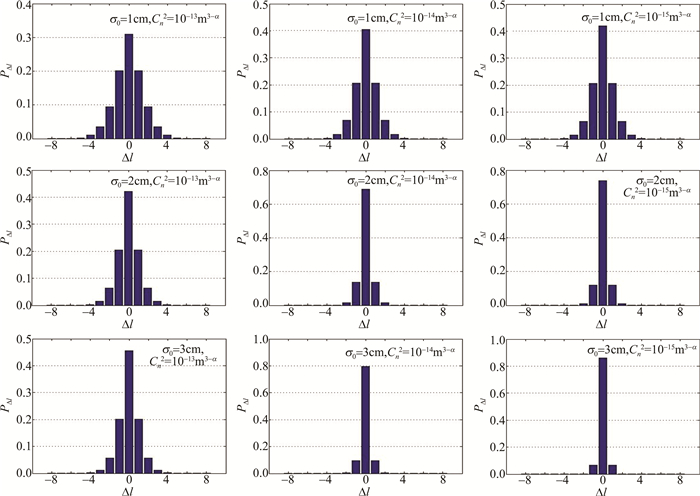






 DownLoad:
DownLoad:

